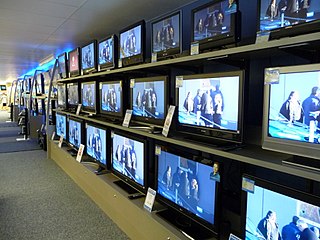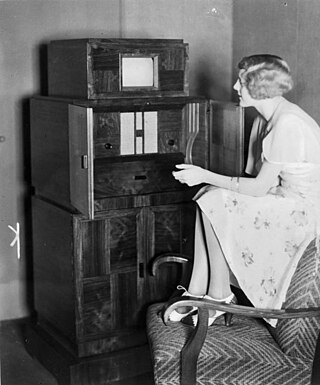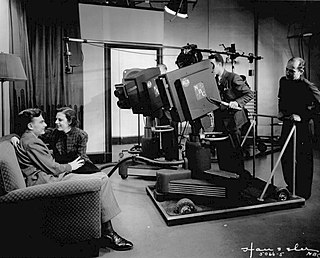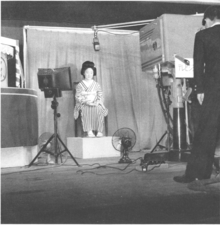
Analog television is the original television technology that uses analog signals to transmit video and audio. In an analog television broadcast, the brightness, colors and sound are represented by amplitude, phase and frequency of an analog signal.

NTSC is the first American standard for analog television, published in 1941. In 1961, it was assigned the designation System M. It is also known as EIA standard 170.

Phase Alternating Line (PAL) is a colour encoding system for analog television. It was one of three major analogue colour television standards, the others being NTSC and SECAM. In most countries it was broadcast at 625 lines, 50 fields per second, and associated with CCIR analogue broadcast television systems B, D, G, H, I or K. The articles on analog broadcast television systems further describe frame rates, image resolution, and audio modulation.

SECAM, also written SÉCAM, is an analog color television system that was used in France, Russia and some other countries or territories of Europe and Africa. It was one of three major analog color television standards, the others being PAL and NTSC. Like PAL, a SECAM picture is also made up of 625 interlaced lines and is displayed at a rate of 25 frames per second. However, due to the way SECAM processes color information, it is not compatible with the German PAL video format standard. This page primarily discusses the SECAM colour encoding system. The articles on broadcast television systems and analog television further describe frame rates, image resolution, and audio modulation. SECAM video is composite video because the luminance and chrominance are transmitted together as one signal.

Television (TV) is a telecommunication medium for transmitting moving images and sound. The term can refer to a television set, or the medium of television transmission. Television is a mass medium for advertising, entertainment, news, and sports.

Interlaced video is a technique for doubling the perceived frame rate of a video display without consuming extra bandwidth. The interlaced signal contains two fields of a video frame captured consecutively. This enhances motion perception to the viewer, and reduces flicker by taking advantage of the phi phenomenon.

Color television or colour television is a television transmission technology that includes color information for the picture, so the video image can be displayed in color on the television set. It improves on the monochrome or black-and-white television technology, which displays the image in shades of gray (grayscale). Television broadcasting stations and networks in most parts of the world upgraded from black-and-white to color transmission between the 1960s and the 1980s. The invention of color television standards was an important part of the history and technology of television.

A test card, also known as a test pattern or start-up/closedown test, is a television test signal, typically broadcast at times when the transmitter is active but no program is being broadcast.
Broadcasttelevision systems are the encoding or formatting systems for the transmission and reception of terrestrial television signals.

Mechanical television or mechanical scan television is an obsolete television system that relies on a mechanical scanning device, such as a rotating disk with holes in it or a rotating mirror drum, to scan the scene and generate the video signal, and a similar mechanical device at the receiver to display the picture. This contrasts with vacuum tube electronic television technology, using electron beam scanning methods, for example in cathode-ray tube (CRT) televisions. Subsequently, modern solid-state liquid-crystal displays (LCD) and LED displays are now used to create and display television pictures.
The 405-line monochrome analogue television broadcasting system was the first fully electronic television system to be used in regular broadcasting. The number of television lines influences the image resolution, or quality of the picture.

The concept of television is the work of many individuals in the late 19th and early 20th centuries. The first practical transmissions of moving images over a radio system used mechanical rotating perforated disks to scan a scene into a time-varying signal that could be reconstructed at a receiver back into an approximation of the original image. Development of television was interrupted by the Second World War. After the end of the war, all-electronic methods of scanning and displaying images became standard. Several different standards for addition of color to transmitted images were developed with different regions using technically incompatible signal standards. Television broadcasting expanded rapidly after World War II, becoming an important mass medium for advertising, propaganda, and entertainment.

A number of experimental and broadcast pre World War II television systems were tested. The first ones were mechanical based and of very low resolution, sometimes with no sound. Later TV systems were electronic.

180-line is an early electronic television system. It was used in Germany after March 22, 1935, using telecine transmission of film, intermediate film system, or cameras using the Nipkow disk. Simultaneously, fully electronic transmissions using cameras based on the iconoscope began on January 15, 1936, with definition of 375 lines.

CCIR System B was the 625-line VHF analog broadcast television system which at its peak was adopted by more than one hundred countries, either with PAL or SECAM colour. It is usually associated with CCIR System G for UHF broadcasts.

625-line is a late 1940s European analog standard-definition television resolution standard. It consists of a 625-line raster, with 576 lines carrying the visible image at 25 interlaced frames per second. It was eventually adopted by countries using 50 Hz utility frequency as regular TV broadcasts resumed after World War II. With the introduction of color television in the 1960s, it became associated with the PAL and SECAM analog color systems.

CCIR System G, also known as the "Gerber Standard", is an analog broadcast television system used in sixty countries around the world for UHF channels. System G is generally associated with System B for VHF.
375-line corresponds to two different electronic television systems, both using 375 scan lines. One system was used in Germany after 1936 along with the 180-line system, being replaced in a few years by the superior 441-line system. It was also tested in Italy around the same time.

343-line is the number of scan lines in some early electronic monochrome analog television systems. Systems with this number of lines were used with 30 interlaced frames per second the United States by from 1935 to 1938, and with 25 interlaced frames per second in the Soviet Union from 1937 onwards. A similar system was under development in Poland in 1939.
The 455-line standard, also known as 450-line, was a French black-and-white analog television broadcasting norm employed between 1937 and 1939. It was later replaced by the 441-line format, which remained in use until 1956.






















